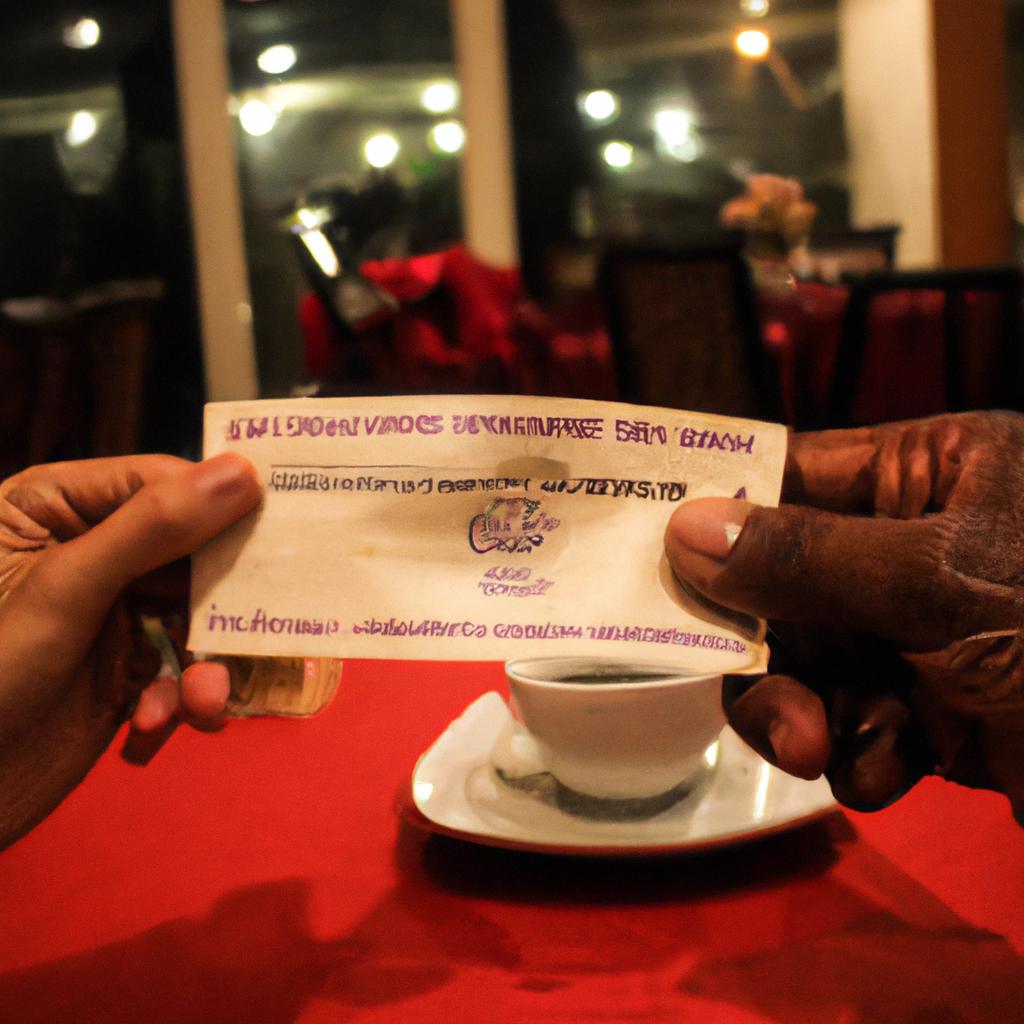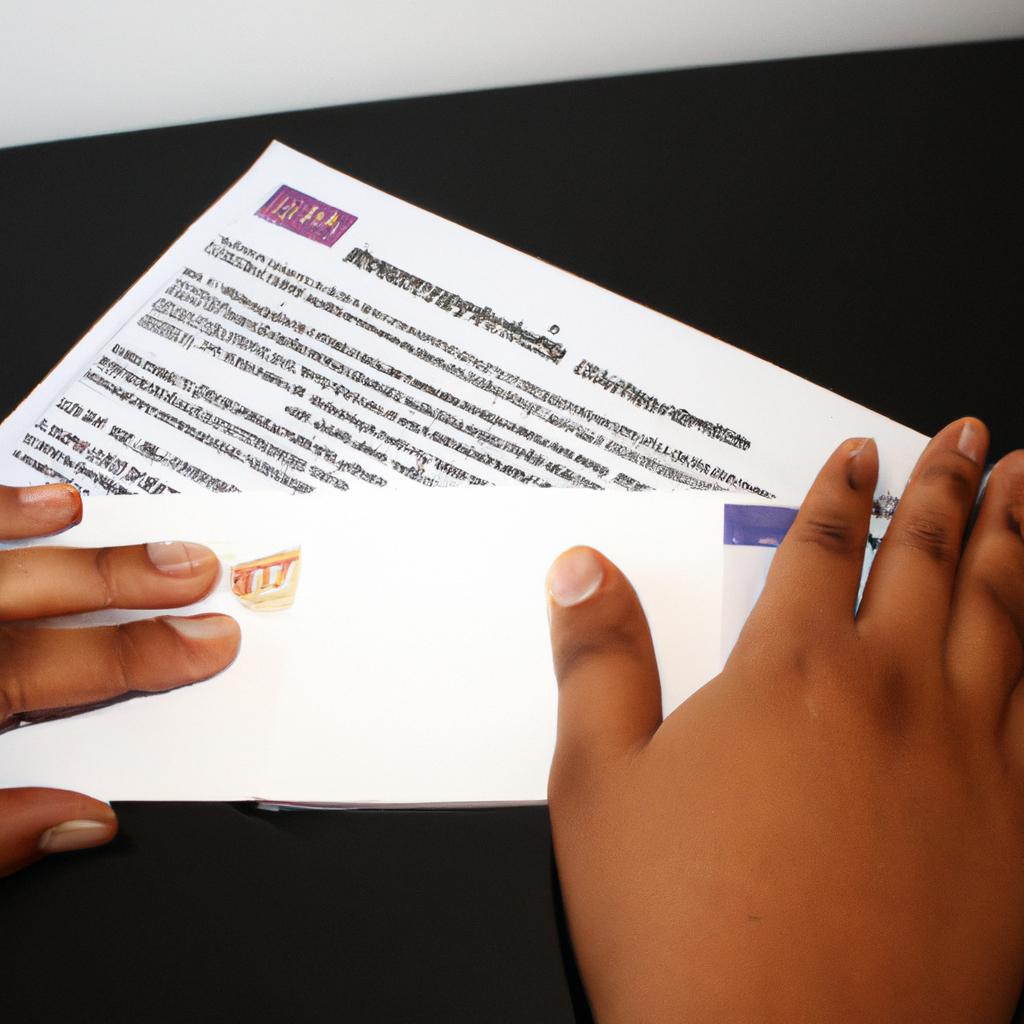The restaurant industry is a thriving sector of the economy, providing employment opportunities and culinary experiences for countless individuals. However, running a successful bar and grill establishment comes with its fair share of financial challenges. One way to alleviate some of these burdens is by taking advantage of tax deductions specifically designed for restaurant owners. By strategically deducting eligible expenses, such as food and beverage costs, equipment purchases, and advertising expenses, bar and grill proprietors can significantly reduce their overall tax liability.
For instance, consider the case of Joe’s Bar & Grill, a popular neighborhood eatery known for its delicious burgers and lively atmosphere. As Joe navigates through the intricacies of managing his business finances, he discovers that there are various tax deductions available to him. With careful record-keeping and adherence to IRS guidelines, Joe can potentially save substantial amounts on his annual tax bill. This article aims to explore the key tax deductions that bar and grill owners like Joe should be aware of in order to maximize their financial assistance while staying within legal boundaries. Through an analysis of common deductible expenses specific to the restaurant industry, this article will provide valuable insights into how bar and grill establishments can optimize their financial strategies through effective use of tax deductions.
Eligible restaurant expenses for tax deductions
Eligible restaurant expenses for tax deductions can significantly reduce the financial burden on bar and grill owners. By understanding which expenses qualify for deductions, establishments can optimize their financial assistance opportunities. To illustrate this point, let’s consider a hypothetical case study of a popular sports bar that has recently renovated its outdoor patio area.
One example of an eligible expense is the cost incurred during renovations or improvements to the establishment. In our case study, the sports bar invested in expanding their outdoor seating capacity and installing weather-resistant furniture. These expenses would be considered necessary for maintaining and improving business operations, thus qualifying them as potential deductions.
- Cost of food and beverages: Expenses related to purchasing ingredients, inventory, and supplies used in food preparation.
- Employee wages and benefits: Salaries, health insurance premiums, retirement contributions, and other employee-related costs.
- Marketing and advertising: Costs associated with promoting the business through various channels such as social media campaigns or traditional marketing strategies.
- Utilities: Expenditures for electricity, water supply, gas consumption, heating/cooling systems required to run day-to-day operations efficiently.
In addition to the bullet points mentioned above, it is worth noting that certain restaurant expenses may not be fully deductible but could still yield some partial benefits. Therefore, it becomes crucial for bar and grill owners to maintain accurate records of all expenditures throughout the year.
To provide a comprehensive overview of eligible expenses at a glance, here is a table summarizing different categories:
| Category | Examples |
|---|---|
| Food & Beverage | Ingredients |
| Inventory | |
| Supplies | |
| Employee | Salaries |
| Wages | Benefits |
| Marketing | Social media campaigns |
| & Advertising | Traditional marketing strategies |
| Utilities | Electricity bills |
| Water supply | |
| Gas consumption | |
| Heating/cooling systems |
Understanding the criteria for restaurant expense deductions is vital for bar and grill owners seeking financial assistance. By identifying eligible expenses, establishments can take full advantage of potential tax deductions to alleviate their financial burden. In the subsequent section, we will delve further into the specific requirements and guidelines set forth by tax authorities regarding these deductions.
Understanding the criteria for restaurant expense deductions
Eligible restaurant expenses for tax deductions play a crucial role in reducing the financial burden faced by bar and grill owners. Understanding the criteria for such deductions can greatly assist them in optimizing their finances and maximizing profitability. For instance, consider a hypothetical case where a local Bar & Grill named “Tasty Bites” incurred several eligible expenses during the fiscal year.
One example of an eligible expense is the cost of purchasing new kitchen equipment to improve efficiency and enhance food quality at Tasty Bites. By investing in high-quality appliances that meet industry standards, the establishment not only ensures compliance with health regulations but also qualifies for tax deductions. This serves as an incentive for business owners to make necessary upgrades and maintain competitiveness within the market.
To shed further light on this topic, here are some key points regarding eligible restaurant expenses for tax deductions:
- Marketing and Advertising: Expenses related to promoting your bar and grill through various channels, such as social media campaigns or traditional advertising methods, can be deducted.
- Professional Services: Payments made to accountants, lawyers, consultants, or other professional services providers who assist in managing legal or financial aspects of your business may qualify as deductible expenses.
- Employee Benefits: Costs associated with providing employee benefits like healthcare coverage or retirement plans may be considered as part of eligible expenses.
- Utilities: Expenditures on utilities such as electricity, gas, water, and sewerage bills required to operate your bar and grill are generally deductible.
To illustrate these points more effectively, let’s take a look at the following table showcasing different eligible restaurant expenses along with their corresponding amounts spent by Tasty Bites during the fiscal year:
| Expense Category | Amount Spent ($) |
|---|---|
| Marketing | 2,500 |
| Professional Services | 1,200 |
| Employee Benefits | 3,000 |
| Utilities | 4,500 |
As can be seen from the table, Tasty Bites allocated a significant portion of their budget towards eligible expenses. This highlights the importance they placed on optimizing their tax deductions and ultimately reducing their overall financial obligations.
In conclusion, understanding the criteria for restaurant expense deductions is crucial for bar and grill owners seeking to maximize profitability. By identifying eligible expenses such as marketing, professional services, employee benefits, and utilities, establishments like Tasty Bites can strategically allocate resources while also benefiting from potential tax savings. In the subsequent section, we will delve into common restaurant expenses that can be deducted on taxes without compromising compliance or financial stability.
Common restaurant expenses that can be deducted on taxes
Understanding the criteria for restaurant expense deductions is essential for maximizing tax benefits. Let’s delve into some common restaurant expenses that can be deducted on taxes and explore how these deductions can benefit businesses in the food industry.
Imagine a small bar and grill establishment called “Delicious Bites,” which incurs various expenses throughout the year. One example of a deductible restaurant expense for Delicious Bites would be their monthly rent payment, as it directly contributes to the operation of their business. This case study highlights the importance of identifying eligible expenses to minimize tax liability effectively.
To provide further clarity, here are several key types of deductible restaurant expenses:
- Food and beverage costs: Expenses related to purchasing ingredients, beverages, and kitchen supplies used in preparing meals.
- Employee wages: Salaries, bonuses, commissions, payroll taxes, and other compensation provided to staff members working at the establishment.
- Utilities: Costs associated with electricity, gas, water usage, internet services, phone bills, and other utilities necessary for running the restaurant.
- Equipment maintenance: Expenditures incurred when repairing or maintaining equipment such as stoves, ovens, refrigerators, dishwashers, etc.
To illustrate the potential impact of these deductions on a restaurant’s financials more clearly:
| Expense Type | Annual Amount ($) | Deductible Amount ($) |
|---|---|---|
| Food Costs | $50,000 | $50,000 |
| Employee Wages | $100,000 | $100,000 |
| Utilities | $15,000 | $15,000 |
| Maintenance | $5,000 | $5 , 0 0 0 |
In this hypothetical scenario based on Delicious Bites’ annual operations data above (not real figures), they could potentially deduct a total amount of $170 , 0 00 from their overall taxable income. These deductions can significantly reduce the tax burden for bar and grill establishments like Delicious Bites, allowing them to allocate those savings towards other business needs.
Understanding the criteria for restaurant expense deductions is crucial in maximizing tax benefits for businesses in the food industry. By identifying eligible expenses and effectively utilizing deduction opportunities, restaurants can minimize their tax liability and optimize financial resources. In the subsequent section about “Documentation required for claiming restaurant expense deductions,” we will explore the necessary paperwork businesses need to gather when filing taxes.
Documentation required for claiming restaurant expense deductions
Tax Deductions for Restaurant Expenses: Bar & Grill Financial Assistance
Imagine you own a popular bar and grill, and you’re looking to maximize tax deductions on your restaurant expenses. To help guide you through the process, we will discuss the documentation required for claiming these deductions. By understanding what records and receipts are necessary, you can ensure that your business receives the financial assistance it deserves.
When it comes to deducting restaurant expenses on your taxes, proper documentation is crucial. Here is an example scenario of how meticulous record-keeping can benefit your establishment:
Case Study:
John owns a successful sports bar in downtown Chicago. He diligently keeps track of all his business-related expenses throughout the year. When it’s time to file his taxes, John realizes he can claim deductions for various costs associated with running his establishment, such as employee wages, rent, utilities, and supplies. With accurate documentation readily available, John confidently submits his claims and receives substantial financial relief for his bar.
To further assist you in navigating this complex landscape, consider the following items that should be included in your documentation when claiming deductions:
- Receipts: Keep detailed records of every expense related to operating your restaurant.
- Invoices: Maintain copies of invoices from suppliers for food ingredients, beverages, cleaning products etc.
- Payroll Records: Document employee wages and benefits paid by your business.
- Bank Statements: Retain bank statements illustrating payments made towards bills or loans.
To illustrate how these deductions could potentially impact your bottom line even more significantly than expected, here is a table displaying potential savings based on different amounts spent:
| Amount Spent | Potential Tax Savings |
|---|---|
| $10,000 | $2,500 |
| $20,000 | $5,000 |
| $30,000 | $7,500 |
| $40,000 | $10,000 |
By maintaining thorough records and understanding the potential tax savings associated with your expenses, you can make informed decisions that benefit your business’s financial health.
In preparation for maximizing tax deductions on restaurant expenses, the following section will provide valuable tips to help you navigate this process effectively. By implementing these strategies, you’ll be well-equipped to secure every possible deduction available to your bar and grill establishment.
Tips for maximizing tax deductions on restaurant expenses
Documentation Required for Claiming Restaurant Expense Deductions
To illustrate the importance of proper documentation when claiming restaurant expense deductions, let’s consider a hypothetical case study. Imagine John owns a popular bar and grill that has been generating substantial revenue over the past year. As tax season approaches, John wants to maximize his deductions on restaurant expenses to minimize his taxable income. However, without adequate documentation, he may face difficulties in substantiating these expenses during an audit.
When it comes to claiming restaurant expense deductions, there are several key documents that you need to keep track of:
-
Receipts: Detailed receipts provide evidence of your business-related expenses such as food purchases, supplies, equipment repairs, and advertising costs. These records should clearly state the date, vendor name and address, description of items or services purchased, amount paid, and method of payment.
-
Invoices: In addition to receipts, invoices can serve as supporting documents for larger expenditures made with vendors or contractors. Make sure to retain copies of all invoices related to renovations, maintenance work, or any other service provided by external parties.
-
Bank Statements: Your bank statements can help verify transactions recorded in your receipts and invoices. They demonstrate that payments were indeed made from your business account and further strengthen your claim for deductible expenses.
-
Payroll Records: If you have employees working at your establishment who incur labor-related expenses (e.g., uniforms), it is crucial to maintain accurate payroll records. These records should include information about wages paid and any associated benefits or allowances provided.
- Accurate documentation protects you during audits
- Proper record-keeping maximizes potential tax savings
- Clear documentation reduces stress and uncertainty
- Consistent tracking ensures financial transparency
Consider adopting an organized approach like using spreadsheets or accounting software to streamline your record-keeping process. By doing so, you will not only save time but also mitigate the risk of losing crucial documents.
| Key Documents | Purpose |
|---|---|
| Receipts | Evidence of business-related expenses |
| Invoices | Support for larger expenditures with vendors or contractors |
| Bank Statements | Verification of recorded transactions |
| Payroll Records | Documentation of labor-related expenses |
By diligently maintaining these records, you will be better equipped to claim restaurant expense deductions successfully. In the subsequent section, we will explore important regulations and limitations associated with such deductions, ensuring that you are well-informed about the requirements set forth by tax authorities.
Important regulations and limitations on restaurant expense deductions
Transitioning from the previous section’s tips, let us now delve into important regulations and limitations surrounding tax deductions for restaurant expenses. To illustrate these concepts further, consider the following scenario:
Imagine a small bar and grill establishment called “Delicious Bites.” In their quest to maximize tax deductions, they meticulously track their expenses and identify opportunities that align with IRS guidelines.
To help you navigate through this complex landscape, we present key considerations when seeking financial assistance in the form of tax deductions for restaurant expenses:
-
Qualified Business Expenses:
- Ensure that your expenses are ordinary and necessary for running your restaurant business.
- Examples include costs related to food supplies, employee wages, rent or mortgage payments, utilities, advertising, insurance premiums, licenses or permits fees, repairs and maintenance.
-
Capital Expenditures:
- Be aware of the distinction between capital expenditures (lasting benefits beyond the current year) and regular operating expenses (short-term benefits).
- While capital expenditures cannot be fully deducted immediately like regular operating expenses, they may qualify for depreciation deductions over time.
-
Entertainment vs. Meal Expenses:
- Understand that entertainment expenses are generally non-deductible under recent tax law changes.
- However, meals provided to employees during work hours or those incurred directly with clients or customers can still be eligible for deduction within certain limits.
-
Documentation Requirements:
- Maintain accurate records of all transactions and keep supporting documentation such as receipts, invoices, bank statements.
- Detailed records will assist in substantiating your claims during an audit.
By adhering to these guidelines and ensuring compliance with applicable laws and regulations while maximizing tax deductions on restaurant expenses in line with IRS requirements, establishments like “Delicious Bites” have successfully navigated their financial challenges.
| Considerations | Description | Example |
|---|---|---|
| Qualified Expenses | Ensure expenses are ordinary and necessary | Purchasing food supplies to prepare menu items |
| Capital Expenditures | Distinguish between capital and operating costs | Buying a new oven vs. replacing kitchen utensils |
| Entertainment vs. Meals | Understand differences in deductibility | Providing meals for employees during work hours |
| Documentation | Keep accurate records and supporting documents | Saving receipts from supplier purchases |
In summary, understanding the regulations and limitations surrounding tax deductions on restaurant expenses is crucial for maximizing financial assistance. By adhering to IRS guidelines, maintaining proper documentation, categorizing expenses appropriately, and being aware of any recent changes or updates, businesses can harness the full potential of available deductions while ensuring compliance with applicable laws.
 Catch 22 MKE
Catch 22 MKE



